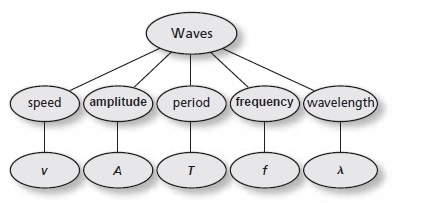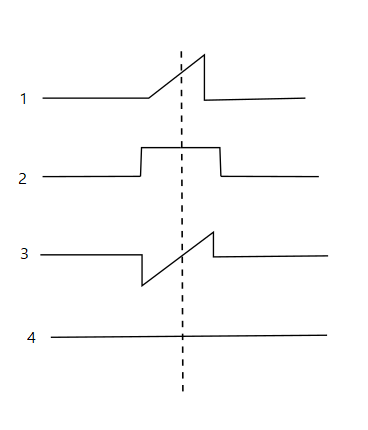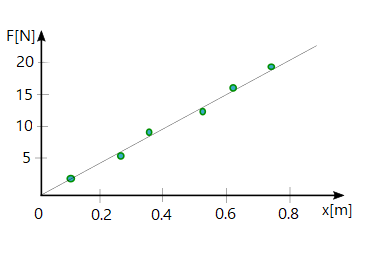All Solutions
Page 396: Assessment

Examples are: oscillating spring, pendulum, uniform rotation etc.
Period is physical quantity that shows time which is taken for one cycle of oscillation. Unit is $textit{second}$ $mathrm{s}$.
Period is time which is taken for one cycle of oscillation.
Examples of simple harmonic motion is: pendulum.
$$
F = (-)kx
$$
In the previous equation:
$F$ – force
$k$ – spring constant
$x$ – stretched (compressed) distance
Therefore, we can conclude that the spring obeys Hooke’s law if its stretched (compressed) distance is proportional to the force which has caused the stretch (compression).
$$
T = sqrt{dfrac{l}{g}}
$$
Where:
$l$ – length of the spring
$g$ – gravitational acceleration
1. by waves (rays of light and sound)
2. by particle transfer (bullet)
Longitudinal waves are waves which oscillations are parallel to the direction at which wave travels.(particles are moving back and forth)
Surface waves are combination of both of them.
$textit{b.}$, Frequency can be changed since the frequency at which waves are produced can be changed.
$textit{b.}$, It can be change since the frequency at which waves are produced can be changed.
They are out of phase if they are not in phase.
Example : Two crests are in phase with each other
And a crest and a trough are out of phase
Interference can be either constructive or destructive; it is constructive in the case of superposition of waves which have same amplitudes in the same direction, those waves are in phase, and it is destructive when those waves have opposite amplitudes, are in opposite phases.
At the beginning of this very motion, elastic potential energy has maximum value, gravitational potential energy has minimum value and kinetic energy equals zero.
When the ball reaches equilibrium position elastic potential energy will be zero, but kinetic energy will reach its maximum value.
Gravitational potential energy will reach its maximum value as the ball reaches highest point of the motion along with the potential energy and kinetic energy will be zero, therefore, we can conclude that total mechanical energy is conserved and did not change.
$C$ and $D$ – less rigid
$x = 0.12, mathrm{m}$
$F = 3.2, mathrm{N}$
Force is given by the following equation:
$$
F = kx
$$
We can express $k$ from the previous equation:
$$
k = dfrac{F}{x}
$$
When we put known values into the previous equation we get:
$$
k = dfrac{3.2, mathrm{N}}{0.12, mathrm{m}}
$$
$$
boxed{k = 27, mathrm{N/m}}
$$
k = 27, mathrm{N/m}
$$
– $k = 25000, mathrm{N/m}$
– $F = 12000, mathrm{N}$
Force is given by:
$$F = kx$$
We can express $x$ from the previous equation:
$$x = dfrac{F}{k}$$
When we put known values into the previous equation we get:
$$x = dfrac{12000, mathrm{N}}{25000, mathrm{N/m}}$$
$$boxed{x = 0.48, mathrm{m}}$$
So;
$PE_{sp}=dfrac{1}{2} k x^{2} =( dfrac{1}{2} ) (27N/m) (0.16m)^{2} = 0.35J$
So,from above equation ;
$x=sqrt{dfrac{2PE_{sp}}{k}} = sqrt{dfrac{(2)(1.5J)}{35 N/m}} = 0.29m$
The spring constant is equal to the slope of the F-x diagram:
$k = slope = dfrac{12.0}{0.60} = 20 N/m$
b)
$$
E = (1/2) k x^2 = (1/2) * (20) * (0.50)^2 = 2.5 J
$$
b) $2.5 J$
– The force: $F_1 = 4 mathrm{~N}$;
– The distance: $x_1 = 0.2 mathrm{~m}$;
– The force: $F_2 = 8 mathrm{~N}$;
– The distance: $x_2 = 0.4 mathrm{~m}$;
**Required:**
a) The constant of the spring $k$;
b) The potential energy of the spring $PE_text{sp}$;
$$y = kx + l$$

$$F = kx$$
$$k = frac{Delta F}{Delta x}$$
$$begin{align*}
k &= frac{F_2 – F_1}{x_2 – x_1} \
&= frac{8 mathrm{~N} – 4 mathrm{~N}}{0.4 mathrm{~m} – 0.2 mathrm{~m}} \
&= 20 ,frac{text{N}}{text{m}}
end{align*}$$
$$boxed{k = 20 ,frac{text{N}}{text{m}}}$$
$$begin{align*}
PE_text{sp} &= frac{Fx}{2} \
&= frac{50 mathrm{~cm} cdot 10 mathrm{~N}}{2} \
&= frac{0.5 mathrm{~m} cdot 10 mathrm{~N}}{2} \
&= 2.5 mathrm{~J}
end{align*}$$
$$boxed{ PE_text{sp} = 2.5 mathrm{~J}}$$
&text{a) } k = 20 ,frac{text{N}}{text{m}} \
&text{b) } PE_text{sp} = 2.5 mathrm{~J}
end{align*}$$
$T = 2.3, mathrm{s}$
$g = 1.6, mathrm{m/s^{2}}$
$l = ?$
Period is given by:
$$
T = 2 pi sqrt{dfrac{l}{g}}
$$
We can easily express $l$ from the previous equation:
$$
l = dfrac{T^{2}g}{4 pi^{2}}
$$
When we put known values into the previous equation we get:
$$
l = dfrac{(2.3, mathrm{s})^{2} cdot (1.6, mathrm{m/s^{2}})}{4 pi^{2}}
$$
Finally:
$$
boxed{l = 0.21, mathrm{m}}
$$
l= 0.21, mathrm{m}
$$
$f = 0.12, mathrm{Hz}$
Period is given by:
$$
T = dfrac{1}{f}
$$
When we put known value into the previous equation and when we express $mathrm{Hz}$ as $dfrac{1}{s}$ we get:
$$
T = dfrac{1}{0.12, mathrm{dfrac{1}{s}}}
$$
$$
boxed{T = 8.3, mathrm{s}}
$$
T = 8.3, mathrm{s}
$$
$lambda= 12, mathrm{m}$
$T = 3, mathrm{s}$
$v= ?$
Since wavelength is given by:
$$
lambda = dfrac{v}{f}
$$
And frequency is given by:
$$
f = dfrac{1}{T}
$$
Speed, expressed by these equations will be:
$$
v = lambda f = lambda dfrac{1}{T}
$$
When we put known values into the previous equation we get:
$$
v = 12, mathrm{m} cdot dfrac{1}{3, mathrm{s}}
$$
$$
boxed{v= 4, mathrm{m/s}}
$$
v= 4, mathrm{m/s}
$$
$lambda = 0.06, mathrm{m}$
$f = 4.8, mathrm{1/s} = 4.8, mathrm{Hz}$
$textit{a.}$, $v=?$
Since wavelength is given by:
$$
lambda = dfrac{v}{f}
$$
Speed, expressed by the previous equation will be:
$$
v = lambda f
$$
When we put known values into the previous equation we get:
$$
v = 0.06, mathrm{m} cdot 4.8, mathrm{Hz}
$$
$$
boxed{v= 0.29, mathrm{m/s}}
$$
Period is given by:
$$
T = dfrac{1}{f}
$$
When we put known values into the previous equation we get:
$$
T = dfrac{1}{4.8, mathrm{Hz}}
$$
$$
boxed{T = 0.21, mathrm{s}}
$$
$textit{b.}$, $T = 0.21, mathrm{s}$
$v = dfrac{d}{t} = dfrac{3.4}{1.8} = 1.9 m/s$
b)
$$
lambda = v T = (1.9) * (1.1) = 2.1 m
$$
b) $2.1 m$
– Distance: $s = 3.4 mathrm{~m}$
– Time: $t = 1.8 mathrm{~s}$;
– Period: $T = 1.1 mathrm{~s}$;
**Required:**
a) Wave speed $v$;
b) Wavelength of the water wave $lambda$;
$$begin{align*}
v &= frac{s}{t}&&(1) \
v &= lambda f &&(2) \
T &= frac{1}{f} &&(3)
end{align*}$$
$$begin{align*}
v &= frac{s}{t} \
&= frac{3.4 mathrm{~m}}{1.8 mathrm{~s}} \
&= 1.9 ,frac{text{m}}{text{s}}
end{align*}$$
$$boxed{ v = 1.9 ,frac{text{m}}{text{s}} }$$
$$begin{align*}
lambda &= frac{v}{f} \
&= vT \
&= 1.9 ,frac{text{m}}{text{s}} cdot 1.1 mathrm{~s} \
&= 2.1 mathrm{~m}
end{align*}$$
$$boxed{ lambda = 2.1 mathrm{~m} }$$
&text{a) } v = 1.9 ,frac{text{m}}{text{s}}\
&text{b) } lambda = 2.1 mathrm{~m}
end{align*}$$
$1 cdot 10^{6}, mathrm{Hz}$
$lambda = 1.5, mathrm{mm} = 1.5 cdot 10^{-3}, mathrm{m}$
$textit{a.}$, $v = ?$
Since wavelength is given by:
$$
lambda = dfrac{v}{f}
$$
We can easily express $v$ from the previous equation:
$$
v = lambda f
$$
When we put known values into the previous equation we get:
$$
v = 1.5 cdot 10^{-3}, mathrm{m} cdot 1 cdot 10^{6}, mathrm{Hz}
$$
$$
boxed{v = 1.5 cdot 10^{3}, mathrm{m/s}}
$$
Period is given by:
$$
T = dfrac{1}{f}
$$
When we put known values into the previous equation we get:
$$
T = dfrac{1}{1 cdot 10^{6}, mathrm{Hz}}
$$
$$
boxed{T = 1 cdot 10^{-6}, mathrm{s}}
$$
Period along with the frequency remains the same.
$textit{b.}$, $T = 1 cdot 10^{-6}, mathrm{s}$
$textit{c.}$, Period along with the frequency remains the same.
$f = dfrac{v}{lambda} = dfrac{330}{0.60} = 550 Hz$
b)
The frequency is 550 Hz therefore 550 waves are emitted per second and 275 waves every 0.50 s.
c)
$$
d = v t = (330)*(0.50) = 165 m
$$
b) 275 waves
c) $165 m$
– Wavelength: $lambda = 0.6 mathrm{~m}$;
– Velocity: $v = 330 ,frac{text{m}}{text{s}}$;
– Time: $t = 0.5 mathrm{~s}$;
**Required:**
a) Frequency $f$;
b) Number of complete waves $n$;
c) Distance from the source $s$;
$$begin{align*}
v &= lambda f &&(1) \
n &= ft &&(2) \
v &= frac{s}{t}&&(3) \
end{align*}$$
$$begin{align*}
f &= frac{v}{lambda } \
&= dfrac{330 ,frac{text{m}}{text{s}}}{0.6 mathrm{~m}} \
&= 550 mathrm{~Hz}
end{align*}$$
$$boxed{ f = 550 mathrm{~Hz} }$$
$$begin{align*}
n &= ft \
&= 550 mathrm{~Hz} cdot 0.5 mathrm{~s} \
&= 275
end{align*}$$
$$boxed{ n = 275 }$$
$$begin{align*}
s &= vt \
&= 330 ,frac{text{m}}{text{s}} cdot 0.5 mathrm{~s} \
&= 165 mathrm{~m}
end{align*}$$
$$boxed{ s = 165 mathrm{~m} }$$
&text{a) } f = 550 mathrm{~Hz}\
&text{b) } n = 275 \
&text{c) } s = 165 mathrm{~m}
end{align*}$$
$$
d = v t = (1498) * (0.9) = 1350 m
$$
1350 m
$$
$lambda = wavelength = (2)*(3.0) = 6.0 m$
$$
v = speed = lambda f = (6.0)*(0.6) = 3.6 m/s
$$
3.6 m/s
$$
– Distance: $d = 3 mathrm{~m}$;
– Number of waves: $n = 12$;
– Time: $t = 20 mathrm{~s}$;
**Required:**
– The speed of waves $v$;
$$begin{align*}
v &= lambda f &&(1) \
n &= ft &&(2) \
end{align*}$$
$$begin{align*}
lambda &= 2d \
&= 2 cdot 3 mathrm{~m} \
&= 6 mathrm{~m}
end{align*}$$
$$begin{align*}
f &= frac{n}{t} \
&= frac{12}{20 mathrm{~s}} \
&= 0.6 mathrm{~Hz}
end{align*}$$
$$begin{align*}
v &= lambda f \
&= 6 mathrm{~m} cdot 0.6 mathrm{~Hz} \
&= 3.6 ,frac{text{m}}{text{s}}
end{align*}$$
$$boxed{ v = 3.6 ,frac{text{m}}{text{s}} }$$
$d = v_{transverse} t = (8.9 km/s) (t)$
For the longitudinal waves:
$d = v_{longitudinal} (t + 68) = (5.1 km/s) (t + 68)$
Therefore:
$(5.1 km/s) (t + 68) = (8.9 km/s) (t)$
$5.1 t + 346.8 = 8.9 t$
$t = dfrac{346.8}{8.9-5.1} = 91.26 s$
$$
d = v_{transverse} t = (8.9 km/s) (91.26) = 812 km
$$
812 km
$$



2., In the second case , amplitude is doubled.
3, Resultant of the pulses will be half of the amplitude of the second pulse if the amplitude of the first one is half amplitude of the second one as well.
lambda = 2cdot 1.5 = 3
$$
$$
v = lambda cdot f = 3cdot 0.3 = 0.9
$$
text{color{#4257b2}0.9 m/s}
$$
$v = 265, mathrm{m/s}$
$l = 63, mathrm{cm} = 0.63, mathrm{m}$
$textit{a.}$, Speed is given by:
$$
v = dfrac{l}{t}
$$
Therefore, $t$ from the previous equation will be:
$$
t = dfrac{l}{v}
$$
$l$ in the case where pulse moves to the string end and then return to the center will be:
$$
d = dfrac{1}{2} cdot 2 cdot 0.63, mathrm{m} = 0.63, mathrm{m}
$$
Now that all of the information are known we can determine $t$:
$$
t = dfrac{0.63, mathrm{m}}{265, mathrm{m/s}}
$$
$$
boxed{t = 2.4 cdot 10^{-3}, mathrm{s}}
$$
$textit{b.}$, It will be below its restin location.
$textit{c.}$, $15, mathrm{cm}$ from the opposite end

color{#c34632}T = 2pisqrt{dfrac{l}{g}}
$$
Substitute : $l = 1.4$ m and $g = 9.8$ m/s$^2$
$$
T = 2pisqrt{dfrac{1.4text{ m}}{9.8text{ m/s}^2}}approx2.4text{ s}
$$
text{color{#4257b2}2.4text{ s}}
$$
$f = 5.1 cdot 10^{14}, mathrm{Hz}$
$c = 3 cdot 10^{8}, mathrm{m/s}$
Wavelength is given by:
$$
lambda = dfrac{c}{f}
$$
When we put known values into the previous equation we get:
$$
lambda = dfrac{3 cdot 10^{8}, mathrm{m/s}}{5.1 cdot 10^{14}, mathrm{Hz}}
$$
$$
boxed{lambda = 5.9 cdot 10^{7}, mathrm{m}}
$$
lambda = 5.9 cdot 10^{7}, mathrm{m}
$$
$lambda_1 = dfrac{c}{f_1} = dfrac{3.0e8}{1600e3} = 188 m$
$lambda_2 = dfrac{c}{f_2} = dfrac{3.0e8}{550e3} = 545 m$
The wavelengths are between 188 m to 545 m.
b)
$lambda_1 = dfrac{c}{f_1} = dfrac{3.0e8}{108e6} = 2.78 m$
$lambda_2 = dfrac{c}{f_2} = dfrac{3.0e8}{88e6} = 3.41 m$
The wavelengths are between 2.78 m to 3.41 m.
b) between 2.78 m to 3.41 m.
They are transverse waves.
b)
Because the water only moves up and down, it does not moves toward the shore.
c)
$T = dfrac{15}{10} = 1.5 s$
d)
$f = dfrac{1}{T} = dfrac{1}{1.5} = 0.67 Hz$
e)
$v = lambda f = (3)*(0.67) = 2.0 m/s$
f)
$$
lambda = dfrac{c}{f} = dfrac{1.8}{0.67} = 2.7 m
$$
b) See explanation
c) $1.5 s$
d) $0.67 Hz$
e) $2.0 m/s$
f) $2.7 m$
– Time: $t = 15 mathrm{~s}$;
– Number of waves: $n = 10$;
– Wavelength: $lambda = 3 mathrm{~m}$;
– Speed: $v_text{actual} = 1.8 ,frac{text{m}}{text{s}}$;
**Required:**
a) The type of wave;
b) The direction in which the energy spreads;
c) The period $T$;
d) The frequency $f$;
e) The velocity $v$;
f) The wavelength $lambda_text{actual}$;
$$begin{align*}
v &= lambda f &&(1) \
T &= frac{t}{n} &&(2) \
f &= frac{1}{T} &&(3)
end{align*}$$
$$begin{align*}
T &= frac{t}{n} \
&= frac{15 mathrm{~s}}{10} \
&= 1.5 mathrm{~s}
end{align*}$$
$$boxed{ T = 1.5 mathrm{~s} }$$
$$begin{align*}
f &= frac{1}{T} \
&= frac{1}{1.5 mathrm{~s}} \
&= 0.67 mathrm{~Hz}
end{align*}$$
$$boxed{ f = 0.67 mathrm{~Hz} }$$
$$begin{align*}
v &= lambda f \
&= 3 mathrm{~m} cdot 0.67 mathrm{~Hz} \
&= 2.01 ,frac{text{m}}{text{s}}
end{align*}$$
$$boxed{ v = 2.01 ,frac{text{m}}{text{s}} }$$
$$begin{align*}
lambda_text{actual} &= frac{v_text{actual}}{f } \
&= dfrac{1.8 ,frac{text{m}}{text{s}}}{0.67 mathrm{~Hz}} \
&= 2.69 mathrm{~m}
end{align*}$$
$$boxed{ lambda_text{actual} = 2.69 mathrm{~m} }$$
&text{a) See the explanation.} \
&text{b) See the explanation.} \
&text{c) } T = 1.5 mathrm{~s} \
&text{d) } f = 0.67 mathrm{~Hz} \
&text{e) } v = 2.01 ,frac{text{m}}{text{s}} \
&text{f) } lambda_text{actual} = 2.69 mathrm{~m}
end{align*}$$
$m g = k Delta x$
Solve for k:
$$
k = dfrac{m g}{Delta x} = dfrac{(68)*(9.80)}{(1710 – 540)} = 0.57 N/m
$$
0.57 N/m
$$
This is 1/4 of the wavelength.
b)
$T = (4)*(0.18) = 0.72 s$
c)
$$
f = dfrac{1}{T} = dfrac{1}{0.72} = 1.4 Hz
$$
b) $0.72 s$
c) $1.4 Hz$
– Time: $t = 0.18mathrm{~s}$;
**Required:**
a) The amount of the wavelength;
b) The period $T$;
c) The frequency $f$;
$$begin{align*}
f &= frac{1}{T}
end{align*}$$

$$begin{align*}
T &= 4t \
&= 4 cdot 0.18 mathrm{~s} \
&= 0.78 mathrm{~s}
end{align*}$$
$$boxed{ T = 0.72 mathrm{~s} }$$
$$begin{align*}
f &= frac{1}{T} \
&= frac{1}{0.72 mathrm{~s}} \
&= 1.4 mathrm{~Hz}
end{align*}$$
$$boxed{ f = 1.4 mathrm{~Hz} }$$
&text{a) See the explanation.} \
&text{b) } T = 0.72 mathrm{~s} \
&text{c) } f = 1.4 mathrm{~Hz}
end{align*}$$
$m = 225, mathrm{g} = 0.225, mathrm{kg}$
$x = 0.094, mathrm{m}$
$x = 0.80, mathrm{m}$
First, we will determine spring constant, and since the Newton’s second law gives: $mg = kx$, $k$ will be:
$$
k = dfrac{mg}{x}
$$
When we put known values into the previous equation we get:
$$
k = dfrac{0.225, mathrm{kg}9.81, mathrm{m/s^{2}}}{0.094, mathrm{m}} = boxed{23, mathrm{N/m}}
$$
Next, we will be using conservation of energy:
$$
E_{p} = E_{k}
$$
$$
rightarrow dfrac{1}{2}kx^{2} = dfrac{1}{2}mv^{2}
$$
We can express velocity from the previous equation:
$$
v= sqrt{dfrac{kx^{2}}{m}}
$$
When we put known values into the previous equation we get:
$$
v = sqrt{dfrac{23, mathrm{N/m} cdot (0.080, mathrm{m})^{2}}{0.225, mathrm{kg}}}
$$
$$
boxed{v = 0.81, mathrm{m/s}}
$$
v = 0.81, mathrm{m/s}
$$
$$
T = dfrac{1}{f}
$$
When we put known values into the previous equation:
$$
T = dfrac{1}{8, mathrm{dfrac{swings}{60, mathrm{s}}}}
$$
$$
boxed{T = 7.5, mathrm{s}}
$$
$textit{b.}$, New period of the ride will be:
$$
T = dfrac{1}{f}
$$
When we put known values into the previous equation we get:
$$
T = dfrac{1}{dfrac{6, mathrm{swings}}{60, mathrm{s}}}
$$
$$
boxed{T = 10, mathrm{s}}
$$
$textit{c.}$, New frequency will be:
Frequency is given by:
$$
f = dfrac{1}{T}
$$
When we put known values into the previous equation we get:
$$
f = dfrac{1}{1 cdot 10^{-1}, mathrm{s}}
$$
$$
boxed{f = 0.10, mathrm{Hz}}
$$
$$
T = 2 pi sqrt{dfrac{l}{g}}
$$
$l$ will be:
$$
l = g dfrac{T^{2}}{4 pi^{2}}
$$
When we put known values into the previous equation we get:
$$
l = 9.81, mathrm{m/s^{2}} dfrac{(7.5, mathrm{s})^{2}}{4 pi^{2}}
$$
$$
boxed{l = 14, mathrm{m}}
$$
$textit{b.}$, $T = 10, mathrm{s}$
$textit{c.}$, $f = 0.10, mathrm{Hz}$
$textit{d.}$, $l = 14, mathrm{m}$
The equation is:
$T = 2 pi sqrt{dfrac{l}{g}}$
If it loses time it means that its period is more than 1 second and therefore its length is longer than usual. We must make the length of the pendulum shorter.
b)
$T_1 = 2 pi sqrt{dfrac{l_1}{g}} = (2)*(3.1416)*(sqrt{dfrac{0.150}{9.80}}) = 0.77734 s$
$T_2 = T_1 – 0.0400 = 0.77734 – 0.0400 = 0.73734 s$
$T_2 = 2 pi sqrt{dfrac{l_2}{g}}$
$$
==> 0.73734 = (2)*(3.1416)*(sqrt{dfrac{0.150}{9.80}})
$$
$==> l_2 = 0.13496 m$
The change of the length must be:
$$
Delta l = l_1 – l_2 = 0.150 – 0.135 = 0.0150 m
$$
b) $0.0150 m$
$l = 10, mathrm{m}$
$m = 20, mathrm{kg}$
$textit{a.}$, Time taken for swing to reach the peak will half a period:
$$
T_{1} = dfrac{1}{2}T
$$
Since period is given by:
$$
T = 2 pi sqrt{dfrac{l}{g}}
$$
We now have:
$$
begin{align*}
T_{1} &= pi sqrt{dfrac{l}{g}}\
&= pi sqrt{dfrac{10, mathrm{m}}{9.81, mathrm{m/s^{2}}}}\
&= 3.17, mathrm{s}\
end{align*}
$$
$$
boxed{T_{1} = 3.17, mathrm{s}}
$$
$textit{c.}$, Kinetic energy will have maximum value at the bottom of the swing.
$textit{d.}$, Potential energy will have maximum value at the top of the swing.
$textit{e.}$, Kinetic energy will have minimum value at the top of the swing.
$textit{f.}$, Potential energy will have minimum value at the bottom of the swing.
$textit{b.}$, There will be no difference in period.
$textit{c.}$, At the bottom of the swing.
$textit{d.}$, At the top of the swing.
$textit{e.}$, At the top of the swing.
$textit{f.}$, At the bottom of the swing.
$k = dfrac{m g}{x} = dfrac{(0.500)*(9.80)}{(0.020)} = 245 N/m$
b)
$m g = k x$
$$
==> m = dfrac{k x}{g} = dfrac{(245)*(0.045)}{9.80} = 1.1 kg
$$
b) $1.1 kg$
– Mass: $m_1 = 500 mathrm{~g}$;
– The stretch: $x_1 = 2 mathrm{~cm}$;
**Required:**
a) The spring constant $k$;
b) The mass $m_2$;
$$begin{align*}
F &= kx &&(1) \
PE_text{sp} &= frac{kx^2}{2} &&(2)
end{align*}$$
$$begin{align*}
k &= frac{F}{ x} \
&= frac{mg}{ x} \
&= dfrac{500 mathrm{~g} cdot 9.81 ,frac{text{m}}{text{s}^2} }{2 mathrm{~cm}} \
&= dfrac{0.5 mathrm{~kg} cdot 9.81 ,frac{text{m}}{text{s}^2} }{0.02 mathrm{~m}} \
&= 245.25 ,frac{text{N}}{text{m}}
end{align*}$$
$$boxed{k = 240 ,frac{text{N}}{text{m}}}$$
$$begin{align*}
m &= frac{kx}{ g} \
&= dfrac{245.25 ,frac{text{N}}{text{m}} cdot 4.5 mathrm{~cm} }{9.81 ,frac{text{m}}{text{s}^2} } \
&= dfrac{245.25 ,frac{text{N}}{text{m}} cdot 0.045 mathrm{~m} }{9.81 ,frac{text{m}}{text{s}^2}} \
&= 1.125 mathrm{~kg}
end{align*}$$
$$boxed{ m = 1.125 mathrm{~kg} }$$
&text{a) } k = 245.25 ,frac{text{N}}{text{m}} \
&text{b) } m = 1.125 mathrm{~kg}
end{align*}$$
The weight of the load is:
$W = m g = (45)*(9.80) = 441 N$
The force on the each of the springs is:
$F = dfrac{W}{2} = dfrac{441}{2} = 220.5 N$
The spring constant is:
$k = dfrac{F}{x} = dfrac{220.5}{0.010} = 22050 = 2.2 times 10^4 N/m$
b)
$E = (1/2) k x^2$
$E = (1/2) (22050) (0.01)^2$
$$
E = 1.1 J
$$
b) $1.1 J$
$v = lambda f = (1.20)*(125) = 150 m/s$
We have:
$v = sqrt{dfrac{F_T}{mu}}$
$$
F_T = mu v^2 = (0.00283)*(150)^2 = 63.7 N
$$
63.7 N
$$
$k = dfrac{F}{x} = dfrac{20}{0.5} = 40 N/m$
b)
$E = (1/2) k x^2 = (1/2)*(40)*(0.5)^2 = 5.0 J$
c)
The force of the spring is not constant and it depends on the length of the spring. When the spring is not stretched yet, the force is zero and it increases to final amount of 20 N.
b) 5.0 J
c) See explanation
– Force: $F = 20 mathrm{~N}$;
– Stretch: $x = 0.5 mathrm{~m}$;
**Required:**
a) The spring constant $k$;
b) The elastic potential energy $PE_text{sp}$;
c) What happens with the work done to stretch the spring;
$$begin{align*}
F &= kx &&(1) \
PE_text{sp} &= frac{kx^2}{2} &&(2)
end{align*}$$
$$begin{align*}
k &= frac{F}{ x} \
&= frac{20 mathrm{~N} }{0.5 mathrm{~m}} \
&= 40 ,frac{text{N}}{text{m}}
end{align*}$$
$$boxed{k = 40 ,frac{text{N}}{text{m}}}$$
$$begin{align*}
PE_text{sp} &= frac{kx^2}{2} \
&= dfrac{40 ,frac{text{N}}{text{m}} cdot ( 0.5 mathrm{~m})^2 }{2} \
&= 5 mathrm{~J}
end{align*}$$
$$boxed{ PE_text{sp} = 5 mathrm{~J}}$$
&text{a) } k = 40 ,frac{text{N}}{text{m}} \
&text{b) } PE_text{sp} = 5 mathrm{~J} \
&text{c) See the explanation.}
end{align*}$$

$Delta F = 15, mathrm{N} – 2.5, mathrm{N} = 12.5, mathrm{N}$
$Delta x = 0.71, mathrm{m} – 0.12, mathrm{m} = 0.59, mathrm{m}$
$$
k = dfrac{12.5, mathrm{N}}{0.59, mathrm{m}} = boxed{21, mathrm{N/m}}
$$
$$
E_{p} = dfrac{1}{2}bh
$$
$h = 10, mathrm{N}$
$b = 0.5, mathrm{m}$
Therefore we have:
$$
E_{p} = dfrac{1}{2} 0.5, mathrm{m} cdot 10, mathrm{N} = boxed{2.5, mathrm{J}}
$$
$textit{c.}$, $E_{p} = 2.5, mathrm{J}$
$T = dfrac{d}{v} =dfrac{1.5 m}{5 m/s} = 0.3 s$
The frequency is:
$$
f = dfrac{1}{T} = dfrac{1}{0.3} = 3.3 Hz
$$
3.3 Hz
$$
Refraction and reflection by Newton’s theory are explained as bouncing of particles at different angles when light hits rough surface and at the same angle when it hits smooth surface in the case of reflection and in the case of refraction, when particles enter a new medium they are being attracted by the particles of which the medium is made which causes bending of light.
Refraction and reflection by Huygens’s theory are explained as change in direction of a ray of light as it bounces off the reflective surface in the case of reflection and change in direction of ray of light as it enters a new medium with different optical density.
Both models are accurate when it comes to description of reflection and refraction, therefore, if we choose either Newton’s or Huygen’s theory, we will not make mistake.
Newton stated that refraction is bending of light as it enters a new medium since the particles will be attracted by the particles from which that medium is made and Huygens stated that refraction is change in direction of the wave as it enters a new medium.
Both theories are accurate.
$m = 1400, mathrm{kg}$
$v_{f} = 112, mathrm{m/s}$
$t = 9.8, mathrm{s}$
$textit{a.}$, Kinetic energy is given by:
$$
E_{k} = dfrac{1}{2}m v_{f}^{2}
$$
When we put known values into the previous equation we get:
$$
E_{k} = dfrac{1}{2} 1400, mathrm{kg} cdot (112, mathrm{m/s})^{2}
$$
$$
boxed{E_{k} = 8.8 cdot 10^{6}, mathrm{J}}
$$
$textit{b.}$, Minimum amount of work that has been done by its engine equals kinetic energy that we have previously calculated.
We cannot calculate total amount of work done because engine has to do more work than the work that it has been doing against the friction.
$$
a_{avg} = dfrac{Delta v}{Delta t}
$$
When we put known values into the previous equation we get:
$$
a_{avg} = dfrac{112, mathrm{m/s}}{9.8, mathrm{s}}
$$
$$
boxed{a_{avg} = 11, mathrm{m/s^{2}}}
$$
$textit{b.}$, It equals kinetic energy. It cannot be calculated since engine has to do more work than it has been done against the friction.
$textit{c.}$, $a_{avg} = 11, mathrm{m/s^{2}}$
$Q = P t = (1000)*(1) = 1000 J$
We have:
$Q = m L_v$
Solve for m:
$$
m = dfrac{Q}{L_v} = dfrac{1000}{2.26e6} = 4.4times 10^{-4} kg
$$
4.4 times 10^{-4} kg
$$
– Time: $t = 1 mathrm{~s}$;
– Power: $P = 1 mathrm{~kW}$;
– Thermal efficiency: $epsilon = 20%$;
– Heat of vaporization: $H_text v = 2.26 times 10^6 ,frac{text{J}}{text{kg}}$;
**Required:**
– Mass $m$ of the water needed to produce $1 mathrm{~kW}$ of power;
$$begin{align*}
Q &= m H_text v &&(1) \
P &= frac{E}{t} &&(2)
end{align*}$$
$$P =0.2 cdot frac{Q}{t} $$
$$begin{align*}
Q &= frac{Pt}{0.2} \
&= frac{1 mathrm{~kW} cdot 1 mathrm{~s}}{0.2} \
&= frac{1000 mathrm{~W} cdot 1 mathrm{~s}}{0.2} \
&= 5000 mathrm{~J}
end{align*}$$
$$begin{align*}
m &= frac{Q}{ H_text v } \
&= frac{5000 mathrm{~J}}{2.26 times 10^6 ,frac{text{J}}{text{kg}}} \
&= 2.21 times 10^{-3} mathrm{~kg}
end{align*}$$
$$boxed{ m = 2.21 times 10^{-3} mathrm{~kg} }$$

